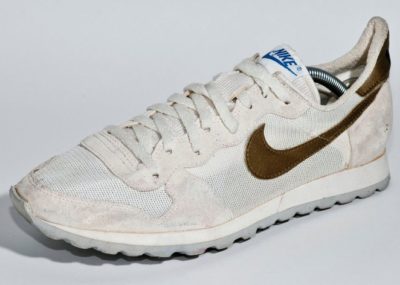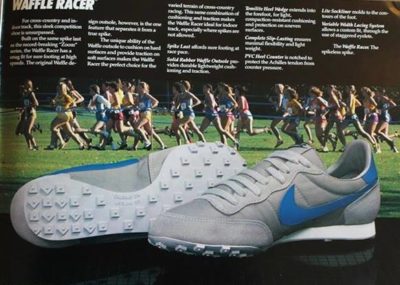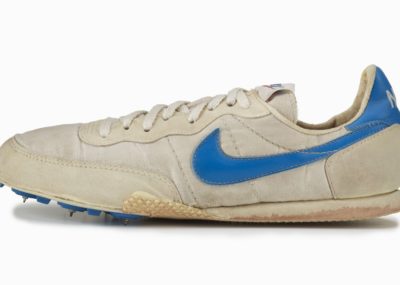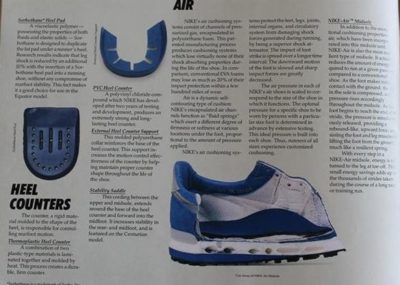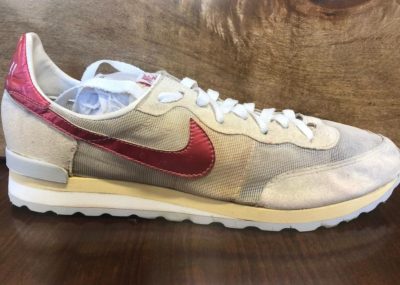5-Aug-1984 – Los Angeles Olympics – 2:24:52 – Nike Skylon Racer
Date of birth: 16-May-1957
Nationality: American
Olympic Record duration: 16 years, 1 month, 19 days
The athlete:
It cannot be understated how significant the 1984 Olympics were for women’s distance running. It was mostly thanks to the efforts of two legends of the sport, Jacqueline Hansen and Kathrine Switzer, that the event took place at all.
Switzer herself made headlines as the first woman to officially run the Boston Marathon back in 1967. She would be equally known for the infamous photographs of a senior race official, who I won’t dignify to name, assaulting her during the race in an attempt to get her to stop.
Hansen was one of the top distance running talents of her generation and held the world record on two separate occasions, first in 1974 and again in 1975. Both women had already started their efforts at lobbying officialdom to have greater inclusion of women in distance running, their efforts going into overdrive near the later parts of their own running careers.
Switzer would turn her focus to sports marketing, and in 1977 was presented by the Avon cosmetics company with an idea for a women’s marathon. Switzer felt the proposal was lacking, and countered with her own much grander vision. She proposed running an international women’s marathon that would expand across the world.
It would crucially allow Switzer to convince the International Olympic Committee (IOC) to add the women’s marathon to the Olympic Games. To do so she would need to organise 25 marathons across three continents. Switzer pitched the countries as those where Avon products were sold. The company accepted her proposal, and once the shock wore off Switzer got to work.
In 1979, with the backing of Nike, Hansen formed the International Runners’ Committee, which lobbied the International Association of Athletics Federations (IAAF) and the IOC at the most senior level. By 1980 she has achieved her first major victory with the 5,000 metre and 10,000 metre distances being recognised as world records for women as well as men.
In the same year Switzer had her proposal ready for the IOC. The 25 marathons she had helped organise had been on five continents, and the report was supported by evidence to show marathon running did not affect women physically any differently to men.
The IAAF would go on to confirm that the women’s marathon would be part of the 1983 World Championships, directly due to the lobbying efforts of Hansen and the International Runners’ Committee. Then In February 1981, the IOC made its announcement in Los Angeles. The women’s marathon would feature at the 1984 Olympics to be held in the same city.
There were still battles to be fought to get other distances included in future Olympics, but you can read more about that in my profile of Jacqueline Hansen’s 1975 world record and later years.
The field for the 1984 Olympic women’s marathon was incredible. Alongside Joan Benoit were Grete Waitz, Ingrid Kristiansen, Joyce Smith, Rosa Mota, Charlotte Teske, and Lisa Martin. Between them were countless marathon victories, world records, and future gold medals in both the Olympics and Commonwealth Games.
It was incredible that Benoit even made the start. In the months leading up to the Olympic Trials, her knee was injured and it got to the point where the only option was surgery. When she got out of surgery, Benoit had only 17 days to recover and get herself ready. It was enough, and she made the cut.
Her training was focussed on preparing for the heat she would face in Los Angeles. By the third mile of the race Benoit was in the lead, even skipping the first water station to avoid getting caught in the pack. Despite concerns her knee would end her race, she was dominant and felt in control throughout.
She crossed the finish line first, securing Olympic gold and her place in history, with Waitz coming in one and a half minutes later. It was also the third fastest women’s marathon of all time, second if you consider Benoit had set one of those times at the Boston Marathon. Due to the amount the Boston Marathon course drops, it is not considered by World Athletics for world record purposes. Her achievements would inspire countless women, and her Olympic record would stand unbroken until 2000.
Benoit would not slow down after her Olympic success, winning the 1985 Chicago Marathon in 2:21:21, which incredibly stood as the American record until 2003. While injuries would cause some issues in later years, Benoit continued competing and participated in the 1996, 2000, and even 2008 Olympic Trials.
The shoes:
When Nike rereleased the Daybreak model in 2019, part of the marketing included that it was the same model that Benoit had worn to Olympic Glory, with pictures of the battle-scarred pair for all to see. This is where things get complicated, as the shoes she wore were actually not the Daybreak.
The YouTube channel SNKRDTLZ was instrumental in helping clear up the mystery, which I’ll now go over. The Daybreak was originally released in 1979, and Benoit wore them loyally in the early stages of her career until 1981. The Daybreak featured two layers of foam cushioning, making it suited more for training than racing.
The first difference is the midsole, which is clearly lower profile than the original Daybreak. If you look closely there is a line towards the heel splitting the midsole. This marks the midsole unit as the one used in the extremely rare version of the American Eagle racing flat given to top Nike athletes. The line likely indicated two different densities of foam.
The outsole itself looks more like the one featured on the American Eagle itself, noting the grey colour compared with the white of the midsole foam. This was in turn shared with the Skylon Racer, another rare shoe from Nike. It was only ever available to the elite athletes it sponsored like Alberto Salazar, Benji Durden, and Mary Decker.
This leads us to the upper. While there is some resemblance to the original Daybreak, the spacing of the overlays is actually much closer to the Skylon Racer. It also closely resembles some of the racing flats Nike made at the time, including the Waffle Racer and the Zoom S, although with a lower section around the back of the foot. Then there is the heel counter.
The original Daybreak did not have an external heel counter like that feature on the shoes Benoit wore. This feature was necessary given Benoit had only recently recovered from knee surgery. The heel counter looks similar to those employed by Nike on many of its running shoes at the time. A version of the Skylon Racer made for American athlete Durden for the 1980 Olympic Trials also featured a heel counter, as well as two layers of midsole foam at the rear. In short, Nike often adapted the Skylon Racer to meet the needs of its elite athletes, including adding stability features when needed. In any case, the shoes that Benoit wore most closely resemble the Skylon Racer and not the Daybreak.
While none of the above in any way diminishes what she achieved, as Nike has been providing its athletes with such prototypes for years. Recently, one Eliud Kipchoge won the 2016 Olympic marathon wearing prototype Nike Zoom VaporFlys. What it does mean that the Daybreak you can buy today as one of Nike’s more popular retro releases has little in common with the shoe that won the first women’s Olympic marathon. You can find out more about the Daybreak and its history in the video below from SNKRDTLZ.
References:
First Ladies of Running by Amby Burfoot
Running Tide by Joan Benoit
A Long Time Coming by Jacqueline Hansen
Marathon Woman by Kathrine Switzer
https://en.wikipedia.org/wiki/Joan_Benoit
https://www.runnersworld.com/races-places/a20804735/the-legacy-of-joan-benoit-samuelsons-olympic-marathon-win/
https://www.nytimes.com/1984/08/06/sports/first-women-s-olympic-marathon-to-benoit.html
https://sports.jrank.org/pages/418/Benoit-Samuelson-Joan-Born-Athlete.html
https://www.nike.com/gb/launch/t/this-day-sneakers-daybreak
https://www.outsideonline.com/1924846/9-questions-joan-benoit-samuelson
https://www.podiumrunner.com/events/samuelson-recalls-1984-olympic-victory/
https://news.nike.com/news/nike-women-advertising-a-40-year-journey
https://sq210.blogspot.com/2011/08/nike-running-history.html
https://www.runnersworld.com/races-places/a20798978/the-1984-los-angeles-olympics-a-run-to-glory/
http://sq210.blogspot.com/2014/04/nike-vintage-smus.html
https://wamsteeker.com/?p=1651
https://www.instagram.com/p/B65666bgtsT/
https://news.nike.com/news/nike-track-spike-history
https://en.m.wikipedia.org/wiki/Stamata_Revithi


